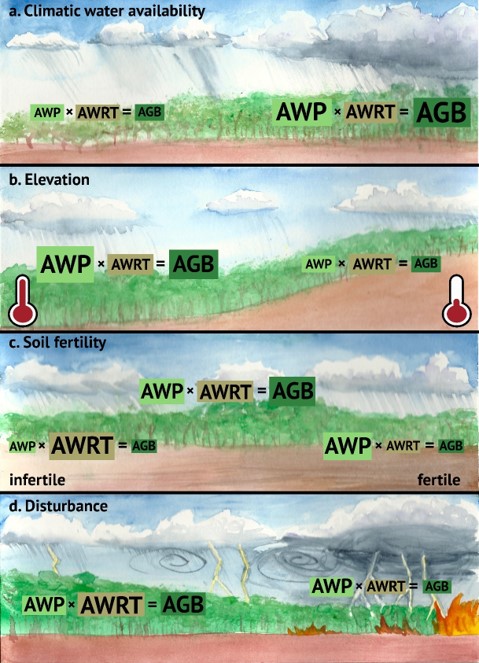The Science
Tropical forests vary widely in woody productivity, tree mortality, and biomass carbon stocks, even for forests of the same age. Reviewing previous studies, we find that productivity is highest in warm, wet forests on fertile soils, whereas mortality is higher at higher soil fertility and higher disturbance. This in turn means that biomass is higher at higher rainfall and temperature, lower disturbance, and intermediate soil fertility.
The Impact
A mechanistic understanding of tropical forest biomass, productivity, and mortality is critical to accurately representing these processes in global vegetation models and predicting responses to global change. By reviewing empirical studies, we describe the state of current knowledge regarding the mechanisms driving carbon dynamics in tropical forests and highlight areas requiring further study.
Summary
We searched the literature for studies of among-site variation in our focal variables (biomass, productivity, and woody residence time) in mature, unlogged tropical forests, or in secondary forests when controlling for stand age. Woody productivity and biomass decrease from wet to dry forests and with elevation. Within lowland forests, productivity and biomass increase with temperature in wet forests, but decrease with temperature where water becomes limiting. Woody productivity increases with soil fertility, whereas residence time decreases, and biomass responses are variable, consistent with an overall unimodal relationship. Areas with higher disturbance rates and intensities have lower woody residence time and biomass. These environmental gradients all involve both direct effects of changing environments on forest carbon fluxes and shifts in functional composition – including changing abundances of lianas — that substantially mitigate or exacerbate direct effects. Biogeographic realms differ significantly and importantly in productivity and biomass even after controlling for climate and biogeochemistry, further demonstrating the importance of plant species composition. Capturing these patterns in global vegetation models requires better mechanistic representation of water and nutrient limitation, plant compositional shifts, and tree mortality.

Contact: Helene C. Muller-Landau, Staff Scientist, Smithsonian Tropical Research Institute, MullerH@si.edu
Funding
KCC was supported as part of the Next Generation Ecosystem Experiments-Tropics, funded by the U.S. Department of Energy, Office of Science, Office of Biological and Environmental Research.
Publications
Muller-Landau, H.C., Cushman, K.C., Arroyo, E.E., Martinez Cano, I., Anderson-Teixeira, K.J., and B. Backiel (2020). Patterns and mechanisms of spatial variation in tropical forest productivity, woody residence time, and biomass. New Phytologist, https://doi.org/10.1111/nph.17084.